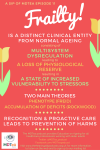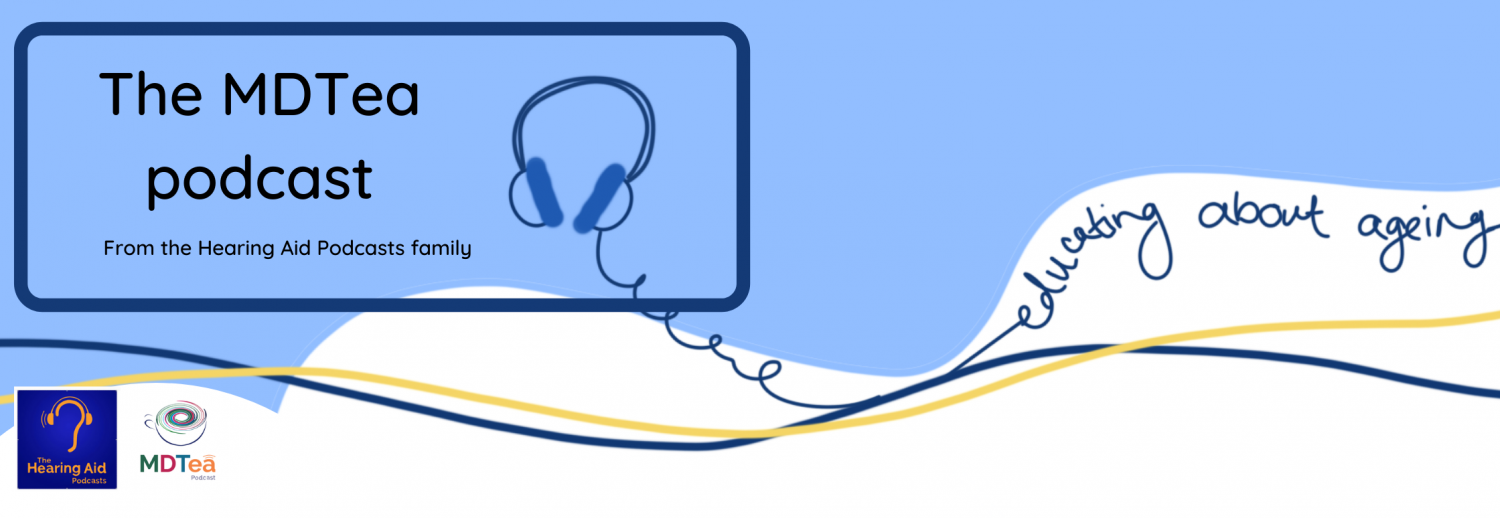Episode 2.1 Frailty
MDTea Episode 2.1: Frailty
Presented by: Jo Preston (Consultant Geriatrician at St George’s Hospital) and Iain Wilkinson (Consultant Geriatrician at East Surrey Hospital).
Core Faculty:Wendy Grosvenor (Nurse Researcher at University of Surrey).
This episode explains the concept of frailty as a distinct entity from normal ageing, introducing some of the main theories behind it. We talk about how to recognise it, why you should and what to do about it once you have!
Click here for the show notes for this episode.
Here is a Sip of MDTea for this episode.

CPD log
Click here to log your CPD online and receive a copy by email.
Episode 2.1 Show Notes
Frailty
___
Presented by: Dr Jo Preston & Dr Iain Wilkinson
Faculty: Iain Wilkinson, Jo Preston, Wendy Grosvenor
Broadcast Date: 23rd August 2016
Learning Outcomes
Knowledge:
- To understand the 2 main theories of frailty definition (Fried/Phenotype and Rockwood/deficit accumulation)
- To be able to know the benefits of risk assessment
Skills:
- To be able to know when and how to identify patients who are frail/pre frail
- To be able to identify situations when frailty can be assessed
Attitudes:
- To understand that frailty is not a subjective opinion but a scientific condition
- To understand that not all frail patients are thin or cachectic
- To recognise the benefits of frailty recognition
Definitions:
Formal / Scientific Definition:
“A state of increased vulnerability to stressors due to age-related declines in physiologic reserve across neuromuscular, metabolic, and immune systems“
Practical Definition:
Frailty is not age, disability or having multiple long term conditions. Frailty is a clinical syndrome whereby the person gradually loses the ability to maintain their homeostasis.
Many definitions though neglect the cognitive and social elements which are so important, if you have good cognition and social support those deficits may not be so apparent
Frailty leads onto a whole host of potential complications – many of which are covered in previous and future episodes of our podcast- e.g. Dehydration (ep8) Delirium(ep2), Inadequate nutrition (in series 2), Skin breakdown, pressure ulcers, Lowered resistance to infection, Falling (ep 5 and in series 2).
There are two main schools of thought at the moment about the way to look for frailty.
Fried:
Fried’s definition is much more simple and is based around 5 characteristics of the patient and was based on a study of 5,300 people from the cardiovascular health study population and 4-7 years of follow up.
To have frailty a patient need 3 or more of:
-
- unintentional weight loss (10 lbs in past year),
- self-reported exhaustion,
- weakness (grip strength),
- slow walking speed,
- and low physical activity
- Being frail was an independent predictor (over 3 years) of falls, worsening mobility or ADL disability, hospitalization, and death.
- Having 1 or 2 showed risk for progression – rehabilitation may address this decline and could therefore be reversible (ref needed).
These are all quite easily measureable. Of them all gait speed is probably the useful on its own and a speed of <1m/s is predictive of poorer health outcomes.
Rockwood:
The second way of looking at frailty is best explained with this quote from the article:
‘As people age, they too experience problems that can accumulate. As deficits (symptoms, signs, illnesses, disabilities) accumulate, people become more susceptible to adverse health outcomes, including worse health and even death. This state of increased risk of adverse health outcomes is indistinguishable from the idea of frailty, so deficit accumulation represents another way to define frailty’.
This leads onto the idea of a frailty index… You look at the maximum possible ‘deficits’ and work out how many your own patient has – which will give you a fraction – or index.
The maximum practical score is 0.7.
A deficit is something that is more common as you get older and confers a poor outcome (i.e hypertension would count, but not white hair).
There have been 3 recent advances / resources to take note of:
- The electronic frailty index:
The eFI uses routine data to identify older people with mild, moderate and severe frailty, with robust predictive validity for outcomes of mortality, hospitalisation and nursing home admission. Routine implementation of the eFI could enable delivery of evidence-based interventions to improve outcomes for this vulnerable group.
2) Frailsafe:
Frailsafe is a bit like ‘fallsafe’ that we talked about in the falls episode (Series 1 Ep 5) Frailsafe is a safety checklist and is being implemented in a number of sites in the UK using QI methodology. They developed a tool which was designed as being able to be simple to use, cheap and effective. In the episode we hear from some members of the frailsafe team from Brighton.
http://www.frailsafe-project.eu/
3) The GP frailty tool kit:
The GP toolkit pulls information from Fit for Frailty which was published by the British Geriatric Society and it suggests using the Clinical Frailty Scale to assess patients for every consultation in patients >75 years. The whole toolkit is really good actually and contains some paperwork for a basic CGA and also the Start-Stopp criteria.
GP toolkit for supporting people with frailty
Fit for frailty. BGS 2014
Exercise can help in frailty. Here are two trials it’s worth having a look at and debating with colleagues:
Curriculum Mapping:
This episode covers the following areas (n.b not all areas are covered in detail in this single episode):
| Curriculum | Area |
| NHS Knowledge Skills Framework | Suitable to support staff at the following levels:
|
| Foundation Curriculum 2012 | 1.3 Continuity of care
2.1 Patient as centre of care 7.9 Interactions with different specialities and other professions 10.1 Long-term conditions |
| Foundation Curriculum 2016 | 2. Patient centred care
4. Self-directed learning 6. Interface with other healthcare professionals 10. The frail patient 10. Support for patients with long term conditions |
| Core Medical Training | Common competences:
System specific competences:
|
| GPVTS program | Section 2.03 The GP in the Wider Professional Environment
Section 3.05 – Managing older adults
|
| ANP (Draws from KSF) | Section 6. Clinical examination
Section 32. Managing frailty |





1 Response
[…] Episode 2.1 Frailty […]